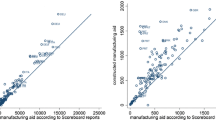Abstract
The EC Treaty substantially reduces the freedom of EU Member States to provide direct economic assistance to enterprises. The main rationale for controlling the use of national state aid at the European level are the potentially negative repercussions of national subsidies on EU market integration. Expressed in per cent of GDP, overall state aid has indeed declined over the last 15 years and state aid to manufacturing, expressed as a percentage of value added, has also fallen. Furthermore, country-specific differences with regard to the use of state aid have been reduced. The econometric analysis conducted in this paper suggests that the increased need for fiscal discipline during most of the 1990s had a considerable impact on the reduction of manufacturing state aid. Were it not for this increased fiscal discipline, state aid to manufacturing might not have remained on a declining trend in the second half of the 1990s.
Similar content being viewed by others
References
See e.g. R. Meiklejohn: The Economics of State Aid, in: European Commission: State Aid and the Single Market, European Economy— Reports and Studies, Vol. 3, 1999, pp. 25–31.
These are described primarily in Art. 87 (2 and 3) but also in Art. 36, 73 and 86(2) of the EC Treaty.
Quoted in B.: Clements and G. Schwartz: Government Subsidies, in: Journal of Economic Surveys Vol. 13, No. 2, 1999, pp. 119–147.
D. Neven: The Political Economy of State Aids in the European Community: Some Econometric Evidence, Discussion Paper No. 945, Centre for Economic Policy Research, London 1994.
For a critical overview see T. Besley and P. Seabright: The Effects and Policy Implications of State Aids to Industry: An Economic Analysis, in: Economic Policy, Vol. 28, 1999, pp. 15–53.
D.C. Mueller: Public Subsidies for Private Firms in a Federalist Democracy, in: G. Galeotti, P. Salmon and R. Wintrobe (eds.): Competition and Structure: The Political Economy of Collective Decision-Making: Essays in Honor of Albert Breton, Cambridge University Press 2000, Chapter 14, pp. 339–363.
See S. Martin and P. Valbonesi: State Aid in Context, in: G. Galli and J. Pelkmans (eds.): Regulatory Reform and Competitiveness in Europe, Vol. 1—Horizontal Issues, Cheltenham 2000, Edward Elgar, pp. 176–201.
D.R. Collie: State Aid in the European Union: The Prohibition of Subsidies in an Integrated Market, in: International Journal of Industrial Organization, Vol. 18, 2000, pp. 867–884.
See T.F. Buss: The Effect of State Tax Incentives on Economic Growth and Firm Location Decisions: An Overview of the Literature, in: Economic Development Quarterly, Vol. 15, No. 1, 2001, pp. 90–105.
See e.g. M. Cini: From Soft Law to Hard Law?: Discretion and Rule-making in the Commission's State Aid Regime, in: RSC No. 2000/35, European Forum Series, EUI Working Papers.
Author information
Authors and Affiliations
Additional information
The views expressed in this paper are those of the authors and do not necessarily reflect the position of the ECB. Helpful comments by A. van Riet, M. Bagella, M. Malgarini and G. Piga as well as secretarial assistance from S. Schleicher Baltrusch are gratefully acknowledged.
Rights and permissions
About this article
Cite this article
Ganoulis, I., Martin, R. State aid control in the European Union— Rationale, stylised facts and determining factors. Intereconomics 36, 289–297 (2001). https://doi.org/10.1007/BF02930146
Issue Date:
DOI: https://doi.org/10.1007/BF02930146



